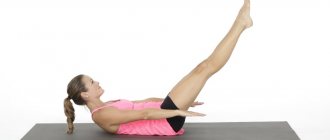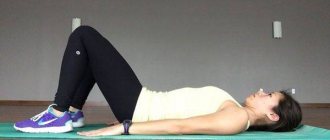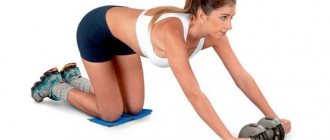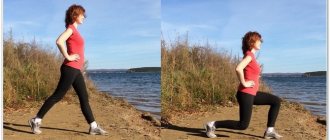Among abdominal exercises, lying leg raises take pride of place. This simple exercise can be performed by both a child and an elderly person. Well-trained athletes perform it daily, using various methods of complication so that not only the lower abs are worked, but also the entire abdominal muscle.
The exercise is suitable for women, young girls, and even people who have undergone surgery. It will be useful to everyone who cares about their own health, during morning exercises and for the prevention of spinal diseases.
What's the benefit?
This exercise has a positive effect on the tone of the body as a whole. With its help, you can perfectly increase the flexibility of the hip joints and develop coordination of movements.
Leg raises while lying on your back strengthen the abdominal muscles, hips and lower back. Increases a person's endurance.
Why do you need leg exercise?
The most accessible exercise at home will be leg raising exercise, since this does not require any additional equipment.
This exercise is necessary for the following reasons:
- is a simple morning exercise accessible to everyone;
- has a positive effect on the abdominal muscles, strengthening their lower part;
- even a physically undeveloped person can easily perform exercises;
- affects the body as a whole, preventing the occurrence of osteochondrosis and intervertebral hernia;
- rehabilitates muscles after surgical interventions in the abdominal cavity.
Execution options
The versatility of this exercise lies in the fact that, depending on your physical fitness, you can choose the appropriate option for yourself:
- raise your legs one by one or at the same time;
- raise both arms and legs;
- use leg weights;
- use a horizontal bench;
- raise your legs while lying on your stomach.
Popular rules for abdominal exercises
For greater efficiency and safety, you must follow some simple rules:
- you cannot lift your body off the floor at the same time as your legs, that is, your back should be pressed tightly to the floor;
- When performing exercises, be sure to have a soft polymer mat on the floor so as not to harm your health;
- exercises must be performed correctly, that is, smoothly and without wasting excess strength;
- when you raise your legs, you must hold them on top for a few seconds;
- strain your abdominal muscles while smoothly lowering your legs to the starting position without jerking;
- no pain should be allowed; it is better to reduce the load on the back;
- legs should not be bent at the knees;
- It is worth doing physical exercise an hour after eating, and after that it is recommended not to eat for 2 hours.
A fairly effective exercise is lifting your legs while lying on your stomach:
You need to lie on your stomach, bend your elbows and place them near your chin. Next, you need to pull in your stomach as much as possible, maintaining tension in your lower back, and place your straight legs shoulder-width apart. Then raise your legs up and lower them until your hips touch the floor again.
The principle of gradualism
You should not perform this exercise by starting with the most difficult option unless you are a professional athlete. The load must be increased carefully so as not to harm the body.
The abdominal muscle needs time to develop, grow, and build endurance, so the principle of gradually increasing the load should be a priority.
For beginners
Untrained people should start by lifting their legs alternately while lying down. In this case, the arms should be extended along the body, and the lower back should be pressed tightly to the floor. Legs are raised alternately to 45 degrees
Exercises in the gym - tips for choosing the best set of exercises. Recommendations for beginners and tips on how to practice correctly (85 photos)A set of exercises for gaining weight - basic exercises and recommendations for selecting weights for exercises
We perform squats with dumbbells - a description of the technique of performing the exercise. Subtleties and secrets of squats for girls (125 photos)
It is advisable to fix the leg in the upper position for two seconds and then smoothly lower it. Exhalation occurs at maximum load. Inhale while lowering. The exercise is performed 10-15 times.
In the postoperative period, it is allowed to raise not a straight leg, but a slightly bent leg. You can lift your head off the floor a little. It is important to monitor how you feel and stop doing the exercise if pain occurs.
Women also do not want to overload their abdominal muscles, especially during the postpartum period.
Execution technique
Initial position
- Place the bench horizontally, check its stability;
- With your back straight, sit on the edge of the bench, tuck your stomach and gently lower yourself to a lying position;
- With your hands, grab the bolsters at the head of the chair, once again tighten your stomach so that your lower back is pressed as much as possible against the bench;
- Raise your legs in a straight or slightly bent position.
Movement
- Lower your legs so that they appear to be a continuation of the spine, that is, the hips are in a plane parallel to the floor;
- Some athletes lower their legs lower until their heels touch the floor, and then work in the opposite direction, but this is best done by those who can physically lower their legs without significantly bending the lower back and lifting it off the floor;
- In any case, the exercise is not performed due to inertia; kicking off the floor is not allowed; you should smoothly and carefully return to the top and repeat the required number of times.
Lying leg raises: 3 execution options
Attention
- The height of the pelvic lift is determined by the degree of twisting. There is no need to lift it up by swinging your legs and inertia; it is enough to smoothly twist it as much as possible if you use only the strength of the press;
- Swinging your legs degrades the quality of your work. You should not perform the movement only due to them, then the front surface of the thigh will be included in the work, and the legs will begin to rise by inertia.
For future athletes
If you set aside at least three days a week for sports, you can move on to the classic exercise: lifting both legs. Lifting angle – 60 degrees. Delay in the upper position – 2 seconds. At the same time, the shoulders, neck and head remain motionless.
Want to make the exercise more challenging? Do not touch the floor with your feet when lowering them; immediately perform the next rise.
Another way to make it more difficult is to hold your legs in the top position for more than two seconds. Depending on your condition, you can perform up to 15 movements in three approaches.
Exercise with weights
It is ideally suited for physically developed people. The starting position is the same - lying on your back. Weights are placed on the ankles. It can be with constant or variable weight.
A dumbbell held by your feet is suitable as a weighting agent. The legs are raised at an acute angle and held for several seconds. Then they smoothly lower and, without touching the floor, move up again.
The best dumbbell press - advice from professionals and basic variations of the basic exercise (75 photos)How to do the plank exercise? Step-by-step description of the correct technique and features of the exercise
Yoga stretching exercises - complexes for beginners and stages of achieving high results (110 photos and videos)
The exercise can be performed in two or three sets up to 30 times.
The accelerated pace of execution perfectly builds endurance.
A set of exercises for legs, hips and buttocks
A set of exercises for legs, hips and buttocks for women:
Straight leg raise while lying on your stomach
Lie on your stomach and rest your forehead on your palms. Raise your straightened leg up. Hold it in this position until you feel tension in your buttock. Then slowly lower your leg. Repeat the same with the second leg.
Raising a leg bent at the knee while lying on your stomach
Lie on your stomach and rest your forehead on your palms. Bend your knee until a right angle is formed. Raise the thigh of your bent leg up to feel the tension in your buttock. Do the same with the second leg.
Raising both legs bent at the knee while lying on your stomach
Lie on your stomach and rest your forehead on your palms. Bend both legs at the knees until a right angle is formed. Lift both legs up at the same time and tighten your buttocks. Hold your legs in this position for 5-10 seconds.
Raising legs with support from arms
Get on your knees and arms straight, keeping your back straight. Raise your leg, straightening it at the knee, then, when it is already raised, bend it at the knee again. The thigh of the raised leg should be above the line of the body. Return to the starting position and do the same with the other leg.
Standing knee bend
Stand straight with your hands on your hips. Stand with your legs slightly apart and your feet out to the sides. Slowly bend your knees and lower yourself down to a 45-degree angle, keeping your hands on your hips at all times. When you reach the lowest position, stand with your knees bent for a few seconds, then slowly return to the starting position.
In the second version of this exercise, you do not need to linger in the lower position, just slowly lower and return to the starting position (this is an easier version of the exercise).
Leg Curl
Lie on your back, preferably on a mat or karimat. Spread your arms out to the sides and lift your legs up, bending your knees slightly, and then pull your feet towards you. Bend both legs, pushing your legs outward without opening your feet. Then lift and straighten your legs with a twist, pulling your knees towards you.
Lateral leg slide
Lie on your back, preferably on a mat or karimat. Place your arms at your sides or along your body and lift your straightened legs up, and then press your feet towards you. Spread your straightened legs as far as possible to the sides and in this position, with your hips bent, try to hold for a few seconds. Then return to the starting position.
Squats
Stand straight with your feet together and your arms hanging freely at your side. Feet should touch the floor - begin to bend your knees and lean down, keeping your feet on the ground while straightening your arms in front of you to maintain your balance. As you lower yourself, bend your back slightly and lower yourself until your thighs are almost parallel to the floor. Remember that your knees should not extend beyond the length of your feet.
Step - performance
This exercise is best done with a stepper, but you can also use a chair or other elevated platform (as long as it is stable). Stand with one foot on the platform, it should be bent at an angle of 90 degrees. Push up with your foot on the platform and in the air replace your legs so that the second one is on the platform. The exercise simulates walking up stairs. An alternative to this exercise is to skip every other step when climbing stairs.
Raising legs and buttocks
For this exercise, you will need a stable exercise table or bench and a cushion. Lie down on the table so that your pelvis and legs protrude beyond its edges and touch the floor. Place a pillow under your head and lean on it, then grab the sides of the chair/bench with both hands.
Holding the edges, lift both straight legs up until they are at the same height as your torso, hold this position for a few seconds and lower back to the ground. Perform the entire exercise slowly.
The second version of this exercise is when you lift both legs, immediately lower them without holding them up for a few seconds (this is an easier version of the exercise).
Abs workout
The lying leg raise exercise is not intended to form sculpted abs. To achieve the desired result, simple leg lifts should be alternated with special abdominal exercises.
These include all kinds of twists (oblique, double, etc.), hanging leg raises, and a popular exercise for the abs in bodybuilding – torso lifts on a Roman chair. These exercises not only create aesthetic abs, but also improve the condition of all internal organs.
What are the errors?
The following mistakes are often encountered when performing lying leg raises:
- separation of the body following the limbs;
- classes on a cold floor without a mat;
- lifting legs with jerks;
- no fixation in the raised position of the legs;
- sudden throwing of legs down;
- do not exercise on a full stomach; wait at least one hour after eating.
You can watch how to perform lying leg raises in the video below.
If you want to become the owner of a flat, beautiful tummy with cubes, it is better to combine lying leg raises with other abdominal exercises and proper nutrition.
Load calculation
For the results to be noticeable, the lying leg raise exercise is performed daily during exercise. First, you should do two sets of ten movements without weights.
Gradually, the load increases, and at the same time muscle development and endurance formation occur. Over time, the relief of the “cubes” becomes noticeable. But you will already have to do other exercises for the abdominal muscles.
The main guideline is your well-being. The load can be either increased or decreased, and consultation with a specialist is simply necessary.
Lying on your back leg raises
Lying on your back leg raises
- an exercise aimed at working mainly the lower abdominals
(
part of the rectus abdominis muscle). In addition to the abdominal muscles, the quadriceps femoris muscle is also involved in the work. There are several options for performing leg raises, each of which differs in the degree of effectiveness and level of safety for the lower back.
These criteria include:
- Body position
. Holding the body up creates an additional static load on the upper part of the rectus abdominis muscle; - Hand position
. If your palms are placed under the lower part of the buttocks, they will slightly lift the pelvis, which will give them an inclined position. A slightly raised pelvis makes it possible to tightly press the lower back to the floor and protect it from the 2 most traumatic phases - at the beginning and end of the lift; - Leg position
. The more the legs are straightened, the greater the amplitude of the execution. The greater the amplitude, the more difficult and effective the exercise, but the greater the load on the lower back; - Using weights
(weights) or a gymnastic ball, which additionally holds the inner thigh in static tension. This is an advanced level of training. The use of weights is aimed at increasing the volume of abdominal muscle mass (those same cubes); - Bench angle
. The lower the bench is inclined, the greater the load on the abdominal muscles. A more difficult option is to lie on a bench, leaving your legs hanging.
Lying leg raises can be performed simultaneously, alternately or sequentially
. In principle, the effectiveness of performing each version of leg lifting is the same, the difference is in the level of safety for the lumbar region. The choice of one or another implementation option also depends on the level of training.
| Exercise characteristics | |
| Type of exercise: | basic |
| Main working muscles: | lower abdominals |
| Additional working muscles: | quadriceps femoris muscle |
| Difficulty of the exercise: | light |
Starting position
: • lie on your back. Place your hands along your body, palms down. Press your head, shoulder blades, lower back and buttocks to the floor. The position of the arms and body can vary, and the lower back must be pressed to the floor; • if you perform the exercise while holding your body in weight, then place your hands behind your head; • Straighten and extend your legs, touching your heels to the floor. Alternatively, your legs can be slightly bent at the knees.
Exercise technique
: • being in the starting position, using the efforts of the abdominal muscles (especially the lower part of the rectus abdominis muscle), exhaling, raise your legs until the hips make a right angle with the body; • slowly, controlling the movement, inhaling, return your legs to their original position; do not lift your lower back off the floor. It should be pressed throughout the entire approach; • As soon as your heels touch the floor, raise your legs again. Do the required number of repetitions.
Recommendations for performing lying leg raises
Don't let your abdominal muscles relax.
Watch your lower back position. She must remain pressed. This is a prerequisite for her safety. Watch the video on the topic
:
What not to do
It is very harmful and even dangerous for health to perform the exercise on a cold floor, and even more so under air conditioning or in a draft.
Facial exercises - types of the best procedures and techniques for performing the exercises necessary for a facelift (135 photos and videos)Review of exercises for men - the most effective comprehensive workouts at home and in the gym (120 photos and videos)
- A set of exercises on simulators - programs for beginners and training tips for women and men (105 photos)
When lifting your legs while lying down, you should not lift your shoulders and head off the floor. The photo below illustrates this common mistake well.
Performing the exercise in jerks leads to indiscriminate contraction of the body muscles, which negatively affects overall well-being.
If there is no delay during the maximum leg lift, this reduces the effectiveness of the exercise.
You should also not exercise “through pain.” Movements should bring satisfaction, not suffering. Any discomfort is a reason to reduce the load.
Common mistakes
Beginning athletes, when performing the exercise of raising legs in a horizontal position, often make a number of mistakes. This not only affects the effectiveness of the workout, but also increases the risk of injury (remember that the spine and lower back are involved in the exercise).
Let's look at the main mistakes:
- Performing the exercise without a gymnastic mat. If you lie on a cold floor without equipment, and your body is hot during the exercise, the risk of lower back inflammation increases. Exercises should be performed in a well-ventilated area.
- Sudden rise and fall of legs. If the exercise is performed at an incorrect and fast pace, inconsistent muscle contraction occurs. To extinguish the resulting inertia, more strength and energy will be required. You simply won't be able to complete the required number of repetitions and will get tired quickly.
- Incorrect execution technique. Each lifting of the legs is accompanied by a delay at the top point for several seconds. This is necessary for the full effectiveness of the training.
- Continuing to perform the workout through strength and back pain. If at the first movements you experience pain in the back area, then you are advised to stop exercising and rest. If the pain recurs, reduce the load and contact an instructor.
- Incorrect leg angle. Don't try to prove to anyone or yourself that you have excellent stretching. The elevation angle is determined to the best of your ability. Otherwise, you risk getting a sprain.
- Workouts after meals. Remember, no physical exercise should begin immediately after eating. It is necessary to wait at least an hour to avoid nausea and vomiting.
- Initial exercises with increased loads. Start each workout with light exercises aimed at warming up the muscles. After this, do the easiest option (lifting your legs one at a time), gradually increasing the load.
Time to workout
Physical activity is not compatible with eating. And not only because the feeling of heaviness and nausea will interfere.
A full stomach will cause the exercises to be performed incorrectly, and there will be no benefit from the exercise. At least an hour, or better yet two, should pass between lunch and training.
Proper nutrition
The “lying leg raise” exercise may be ineffective if the diet is not followed. The abs will simply be masked by a layer of fat in the abdominal area.
That is why it is useful to count calories daily, monitor your diet, and properly dose physical activity.











